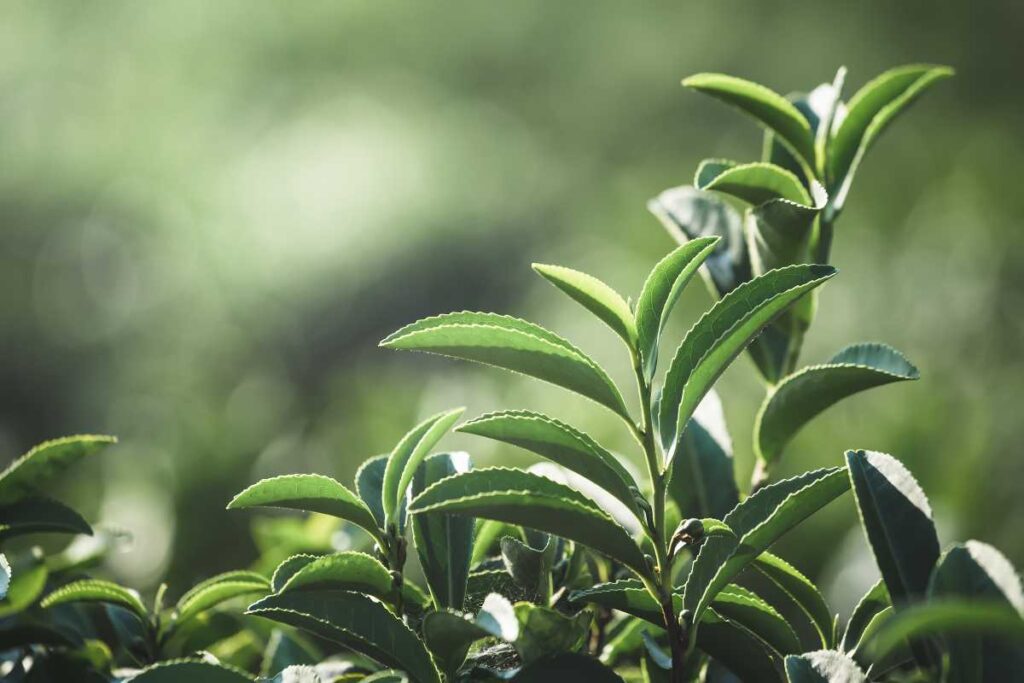Loose Tea Leaves: Your Guide to Premium Quality Tea

Reading tea leaves is an ancient practice that has been around for centuries. It involves interpreting the patterns and shapes formed by tea leaves in a cup. This practice is believed to have originated in China and the Middle East, where it was used as a way of divining the future.
To read tea leaves, you need to begin by brewing a pot of leaf tea. Leaf teas are commonly used for tea leaf reading, as they tend to produce clearer and more distinct patterns compared to finely ground teas like matcha. Once you have brewed your tea, pour it into a cup and allow it to cool slightly.
As you drink your tea, focus on your question or intention. When you have finished drinking, leave a small amount of liquid in the bottom of the cup and swirl it around three times clockwise before turning the cup over onto a saucer. The patterns and shapes that are left behind can be interpreted as symbols or omens.
Tea leaf readers believe that certain patterns can indicate good fortune or bad omens. For example, a letter shape may indicate news or communication, while a skull shape may indicate danger. Other common symbols include hearts (love), stars (success), and birds (freedom). While not scientifically proven, many people find tea leaf reading to be a fun and interesting way to gain insight into their future.
If you’re interested in trying tea leaf reading for yourself, there are many online resources available that can help you get started. You can order some leaf tea online with free delivery on Tuesdays or visit your local specialty store to purchase some high-quality loose-leaf teas.
So why read tea leaves? For many people, it’s simply a fun way to explore their intuition and gain insight into their future. Others may use it as a tool for self-reflection or personal growth. Whatever your reason for exploring this ancient practice, remember that interpretation is subjective and should be approached with an open mind and a sense of curiosity.
Types of loose-leaf teas available
Loose Leaf Tea: A World of Flavors
Loose leaf tea is a type of tea that is not packed in tea bags. It’s known for its superior quality and taste, as it allows the leaves to fully expand and release their flavors. There are many types of loose leaf teas available, each with its unique flavor profile and health benefits.
Loose Leaf Tea Variety Pack: Discover New Flavors
If you’re new to loose leaf tea or want to try different types of teas, a loose leaf tea variety pack is an excellent option. These packs typically contain several different types of teas, such as black, green, oolong, white, and herbal blends. They’re perfect for sampling new flavors and discovering your favorites.
Herbal Tea Loose Leaf: Delicious and Caffeine-Free
Herbal tea loose leaf is a popular type of loose leaf tea that does not contain any actual tea leaves. Instead, it’s made from herbs, fruits, and spices. Herbal teas come in many flavors such as peppermint, chamomile, ginger lemon honey etc., making them an ideal caffeine-free alternative to traditional teas.
Tea Forte Single Steeps Loose Leaf Tea Sampler: Convenience at Its Best
The Tea Forte Single Steeps Loose Leaf Tea Sampler is an excellent option for those who prefer convenience without compromising on quality or flavor. This collection contains single-serve pouches that contain a variety of loose-leaf teas including herbal blends and classic teas like Earl Grey or Darjeeling.
Small Business Brands: High-Quality Loose Leaf Teas
Small business brands offer a wide range of high-quality loose leaf teas that often come in sample pouches allowing customers to try different flavors before committing to larger quantities. Many small businesses also sell whole tea leaves near me making it easy for customers to purchase fresh high-quality products locally.
FAQs:
What are the best tea leaves?
The best type of tea leaves depends on personal preference. Black, green, oolong, and white teas all have their unique flavor profiles and health benefits.
Where to buy loose tea leaves?
Loose tea leaves can be purchased online or at specialty tea shops. Many small businesses also sell high-quality loose leaf teas locally.
What tea leaves for chai?
Chai is typically made with black tea leaves and a blend of spices such as cinnamon, cardamom, cloves, ginger, and pepper.
What tea leaves have caffeine?
Black, green, oolong, and white teas all contain caffeine. Herbal teas do not contain any actual tea leaves and are therefore caffeine-free.
Benefits of consuming loose-leaf tea over bags or powders
Purer Taste with Loose-Leaf Tea
One of the main benefits of consuming loose-leaf tea over tea bags or powders is the purer taste. Loose-leaf tea is made from whole leaves, which means that you get more flavor and aroma in every cup. In contrast, tea bags and powders are often made from broken or ground-up leaves, which can result in a weaker taste.
Loose-leaf tea also allows for better control over the brewing process. With tea bags, you’re limited to the amount of tea that’s been pre-packaged into each bag, which can make it difficult to achieve your desired strength or flavor. However, with loose-leaf tea, you have the freedom to measure out exactly how much you want to use per cup, allowing for a more personalized experience.
Healthier Choice with Organic Products
Another benefit of loose-leaf tea is that it’s often made from organic products, making it a healthier choice. Tea bags and powders may contain additives or preservatives that can be harmful to your health. On the other hand, loose-leaf teas are generally free from these additional ingredients.
In addition to being organic, many loose-leaf teas are also fair trade and sustainably sourced. This means that not only are you benefiting your own health by drinking them but also supporting ethical practices in the industry.
Better Value for Money
Buying loose-leaf tea can also provide better value for money than purchasing pre-packaged options. Loose-leaf teas are usually measured in ounces rather than individual servings like teabags or powders.
While they may seem more expensive upfront because of this larger quantity measurement, they actually offer better value since they last longer and require less packaging overall.
Whole Herbs and Spices Offer More Health Benefits
Loose-leaf teas allow for the use of whole herbs and spices which provide more health benefits compared to their processed counterparts found in teabags or powders. For example, adding a cinnamon stick to your loose-leaf tea can help regulate blood sugar levels and improve digestion.
Many online retailers offer free delivery for loose-leaf tea purchases, making it a convenient option for those who prefer to shop from home. Since loose-leaf teas require less packaging than their pre-packaged counterparts, they’re also more environmentally friendly.
Understanding the art of brewing loose-leaf tea
Using a tea infuser or strainer is essential in brewing loose-leaf tea. This method allows the water to flow freely through the leaves, extracting all of the flavors and aromas. It is recommended to use one teaspoon of loose tea per cup of water, or one ounce per quart. However, this can vary depending on personal preference.
Water quality is crucial when it comes to brewing loose-leaf tea. Impurities such as chlorine or minerals can affect the taste and aroma of the tea. It is best to use filtered water or spring water for optimal results. The soil in which the tea leaves are grown can also impact the flavor profile of the tea. Different regions produce different types of teas with unique tastes and aromas.
Small businesses like Harney & Sons offer a wide variety of loose-leaf teas that can be delivered straight to your doorstep through their website. They have an extensive selection ranging from classic black teas to exotic blends like Paris and Bangkok. Their website also offers free delivery within Florida for orders over $25.
When brewing loose-leaf tea, it is important to turn off the heat once the water reaches boiling point and let it cool for a minute before pouring over the leaves. Using a handle when pouring will prevent burns from hot steam rising from your cup or teapot.
Different brewing methods for different types of tea
Herbal Tea: The Boiling Method
Herbal tea is a popular beverage made by steeping herbs, spices, and other plant materials in hot water. It’s a great way to unwind after a long day or to soothe an upset stomach. To get the most out of your herbal tea, it’s important to use the right brewing method.
The boiling method is best for herbal teas because it allows you to extract the full flavor of the herbs. To brew herbal tea using this method, bring water to a boil and then pour it over your herbs in a teapot or infuser. Let the mixture steep for 5-7 minutes before straining out the leaves and enjoying your delicious cup of tea.
Green Tea: The Gentle Method
Green tea is known for its delicate flavor and health benefits. However, if brewed incorrectly, it can become bitter and unpleasant. That’s why it’s important to use the gentle brewing method when making green tea.
To brew green tea using this method, heat water until it reaches 175°F (80°C). Pour the hot water over your green tea leaves and let them steep for 2-3 minutes. This will prevent bitterness while still allowing you to enjoy all the benefits of this delicious drink.
Black Tea: The Strong Method
Black tea is one of the most popular types of tea in the world due to its strong flavor and high caffeine content. Brewing black tea requires boiling water and a longer steep time than other types of teas.
To brew black tea using this method, bring water to a rolling boil before pouring it over your black tea leaves in a teapot or infuser. Let them steep for 3-5 minutes before straining out the leaves and enjoying your robust cup of black tea.
Iced Tea: Two Methods
Iced tea is perfect for hot summer days or as a refreshing drink any time of year. There are two methods for making iced tea: the hot method and the cold-brew method.
The hot method involves brewing tea at double strength and then pouring it over ice. This will dilute the tea to its desired strength while still keeping it cool. The cold-brew method involves steeping tea in cold water in the refrigerator overnight. This will give you a smooth, refreshing cup of iced tea without any bitterness.
Caffeine Content
Caffeine content varies depending on the type of tea and brewing method used. Black tea contains the most caffeine, with an average of 47 milligrams per eight-ounce cup. Green tea contains less caffeine, with an average of 28 milligrams per eight-ounce cup. Herbal teas contain no caffeine at all.
How to store loose-leaf tea properly
Store: Keep Your Loose-Leaf Tea Fresh
To get the most out of your loose-leaf tea, it is essential to store it properly. The way you store your tea leaves can affect their flavor, aroma, and freshness. Here are some tips on how to keep your loose-leaf tea fresh and flavorful.
Airtight Container: Prevent Air, Moisture, and Light from Affecting Flavor
The best way to store loose-leaf tea is in an airtight container that will prevent air, moisture, and light from affecting its flavor. Exposure to air can cause the tea leaves to lose their flavor and aroma over time. Moisture can make the leaves moldy or stale. And exposure to light can cause the leaves to become bitter.
When choosing a container for your loose-leaf tea, look for one that is made of glass or ceramic material with an airtight lid. Avoid using plastic containers as they may absorb odors and flavors from other foods stored nearby.
Save: Keep Tea Leaves Away from Strong Odors
Tea leaves have a delicate flavor that can easily be affected by strong odors. To avoid unwanted scents being absorbed by your tea leaves, save them away from spices or other strong-smelling foods.
If possible, use separate containers for different types of teas to avoid cross-contamination of flavors. For example, don’t store green tea with black tea as they have different aromas and flavors.
Pack: Maintain Freshness by Packing Small Quantities
Packing small quantities of loose-leaf tea is another way to maintain its freshness. When you open the container every time you make a cup of tea, exposing the entire batch can lead to air getting inside which affects freshness.
Instead of packing all your loose-leaf teas together in one large container or baggie, pack them in smaller amounts so that only what you need is exposed each time you open them up. This will help to keep the tea leaves fresh and flavorful for longer.
Store: Keep Tea Leaves in a Cool, Dry, and Dark Place
To extend the shelf life of your loose-leaf tea and preserve its quality, store it in a cool, dry, and dark place. A pantry or cupboard is an ideal location as long as it is not near any heat sources or areas with high humidity.
Avoid storing your tea leaves in the fridge or freezer as they can absorb moisture and odors from other foods. Also, avoid storing them on a countertop where they may be exposed to sunlight.
Exploring the taste profiles of different teas
Assorted Variety Tea Boxes: Discovering Different Flavors and Blends
Tea enthusiasts are always on the lookout for new flavors and blends to try. Assorted variety tea boxes offer a wide range of choices, making it easier to discover different taste profiles. With so many options available, it can be overwhelming to decide which teas to try. That’s where Tiesta Tea’s sampler set comes in handy.
Tiesta Tea’s sampler set provides a convenient way to try out various teas and find the perfect taste profile. The set includes 12 loose-leaf tea pouches with four different flavors: Fruity Pebbles, Nutty Almond Cream, Fireberry, and Lavender Chamomile. Each flavor has its unique taste profile, allowing tea enthusiasts to explore different blends and find their favorites.
Chai Tea: A Distinctive Taste Profile
One type of tea that has a distinctive taste profile is chai tea. Chai is a spiced black tea that originated in India but has become popular worldwide. The spices used in chai vary depending on the region and personal preference but typically include cinnamon, cardamom, ginger, cloves, and black pepper.
Chai tea has a bold flavor with notes of spice and sweetness. It can be enjoyed hot or cold and is often served with milk or creamer to balance out the spices’ intensity. Chai lattes have also become popular at coffee shops worldwide.
White Tea: A Delicate Taste Profile
Another type of tea with a distinct taste profile is white tea. White tea is made from young leaves and buds that are picked before they fully open and undergo minimal processing compared to other types of teas.
White teas have delicate floral notes with subtle hints of sweetness. They are light-bodied with low caffeine content compared to other types of teas like black or green teas.
Small Business Shops: High-Quality Teas with Sustainable Practices
Small business shops offer organic and climate pledge-friendly tea products with product certification, ensuring customers get high-quality teas with sustainable practices. These small businesses often source their teas directly from farmers, ensuring fair trade practices and reducing the carbon footprint of transportation.
Assorted variety tea boxes and sampler sets provide a convenient way to explore different flavor profiles and find new favorites. Chai tea’s bold spiced flavor and white tea’s delicate floral notes are just two examples of the many types of teas available to try. Small business shops’ organic and climate pledge-friendly products ensure that customers can enjoy high-quality teas while supporting sustainable practices.
How to pair loose-leaf tea with food
Pairing loose-leaf tea with food can be a delightful experience for the palate. The key is to choose the right type of tea that complements the flavors of your dish. Here are some tips on how to pair loose-leaf tea with food.
Black Tea: Bold Flavors
If you’re having a chocolate dessert or a hearty red meat dish, black tea is an excellent choice. Black tea has a robust flavor that can stand up to bold flavors and spices. For example, Earl Grey pairs perfectly with dark chocolate cake or rich beef stew. If you prefer something less traditional, try pairing Darjeeling with spicy Indian curry.
Green Tea: Light and Fresh Flavors
Green tea has a light and refreshing taste that goes well with light and fresh flavors like seafood or salads. For instance, Japanese green tea like Sencha or Gyokuro complements sushi rolls beautifully. Matcha also works wonders when paired with fruit salad or grilled shrimp skewers.
Oolong Tea: Savory Dishes
Oolong tea has a unique flavor profile that’s somewhere between green and black teas. It’s perfect for complementing savory dishes like Thai or Chinese cuisine. For instance, Tie Guan Yin oolong pairs well with spicy Szechuan chicken while Wuyi Rock oolong goes beautifully with roasted duck.
Herbal Tea: Versatile Pairings
Herbal teas are incredibly versatile they’re made from herbs and spices such as chamomile, mint, ginger, or lemongrass. To find the best match for your meal, consider pairing herbs in your herbal tea blend with herbs in your dish.
The history and cultural significance of loose-leaf tea
Oolong Tea: A Unique Loose-Leaf Tea
Oolong tea is a type of loose-leaf tea that originated in China and is known for its unique taste and aroma. Oolong tea leaves are semi-oxidized, which gives them a flavor profile that falls somewhere between green tea (which is not oxidized) and black tea (which is fully oxidized). The process of making oolong tea involves withering the leaves, rolling them to release their juices, and then drying them in the sun or oven.
Loose-Leaf Tea in Ancient Times
The use of loose-leaf tea dates back to ancient times, with evidence of tea leaves being used in China as early as the Han Dynasty (206 BCE – 220 CE). During this time, loose-leaf tea was often used for medicinal purposes. It wasn’t until later on that it became a popular beverage among the Chinese people. In fact, during the Tang Dynasty (618–907 CE), loose-leaf tea was so prized that it was used as a form of currency.
Tea Leaves in India
In India, tea leaves were first introduced by the British in the 19th century and quickly became a popular beverage among the locals. Today, India is one of the largest producers of tea in the world. While most Indian teas are made from small pieces of broken leaves rather than whole ones like loose-leaf teas, there are some exceptions such as Darjeeling and Assam teas.
Fortune-Telling with Loose-Leaf Tea
In some cultures, loose-leaf tea leaves are used for fortune-telling and divination. This practice is known as tasseography or “reading” tea leaves. The shapes and patterns formed by the leftover leaves at the bottom of a cup after drinking are believed to hold symbolic meanings. For example, if you see an image resembling an animal or object in your cup, it is said to have a specific meaning. While there is no scientific evidence to support the practice of tasseography, it remains a popular tradition in many cultures.
Cultural Significance of Loose-Leaf Tea
Loose-leaf tea has played a significant role in various cultural traditions and ceremonies. For example, the Japanese tea ceremony (also known as chanoyu) is a formalized ritual that involves the preparation and presentation of matcha (powdered green tea). The British also have their own tea-related traditions, such as afternoon tea. This typically involves serving loose-leaf black teas along with small sandwiches and pastries.
Why loose-leaf tea is worth the investment
Investing in loose-leaf tea is not just about enjoying a cup of hot beverage. It’s about indulging in the rich history, culture, and tradition that comes with it. Loose-leaf tea offers a plethora of benefits for those who are willing to invest their time and effort into it.
Firstly, loose-leaf teas come in various types and flavors, each with its unique taste profile. From delicate white teas to robust black teas, there’s something for everyone. Unlike tea bags or powders, loose-leaf teas retain their natural oils and flavor compounds that are essential for creating a complex taste experience.
Brewing loose-leaf tea is an art form that requires precision and attention to detail. Understanding the brewing process can elevate your drinking experience by producing a cup of tea that’s perfectly balanced in flavor and aroma. Different types of teas require different brewing methods such as water temperature, steeping time, and amount of leaves used.
Proper storage is crucial store it in an airtight container away from direct sunlight or moisture. This will ensure that you get the best possible flavor every time you brew a cup.
Pairing loose-leaf tea with food can enhance both the taste of your meal and your drinking experience. For example, pairing Darjeeling black tea with chocolate cake can bring out the fruity notes in the tea while complementing the sweetness of the dessert.
Lastly, investing in loose-leaf tea means investing in its rich cultural significance. The ritualistic aspect of preparing and serving loose-leaf tea has been practiced for centuries across different cultures around the world. By indulging in this tradition, you’re connecting with history while enjoying a delicious cup of tea.




